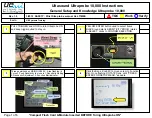
Concepts and Features
R&S
®
ZNC
68
User Manual 1173.9557.02 ─ 13
within the entire sweep range. In some calibration procedures (TRL, TNA, TRM), part
of the characteristics of the standards can be auto-determined due to implicit redun-
dancy (self-calibration).
2. The analyzer compares the measurement data of the standards with their known,
ideal response. The difference is used to calculate the system errors using a particular
error model (calibration type) and derive a set of system error correction data.
3. The system error correction data is used to correct the measurement results of a DUT
that is measured instead of the standards.
Calibration is always channel-specific because it depends on the hardware settings, in
particular on the sweep range. The means that a system error correction data set is stored
with the calibrated channel.
The analyzer provides a wide range of sophisticated calibration methods for all types of
measurements. Which calibration method is selected depends on the expected system
errors, the accuracy requirements of the measurement, on the test setup and on the types
of calibration standards available.
Due to the analyzer's calibration wizard, calibration is a straightforward, menu-guided
process. Moreover, it is possible to perform the entire calibration process automatically
using a Calibration Unit (accessories R&S ZV-Z5x).
The system error correction data determined in a calibration procedure are stored on the
analyzer. You can read these correction data using the remote control command
[SENSe<Ch>:]CORRection:CDATa
. You can also replace the correction data of the
analyzer by your own correction data sets.
Cal Off label
A label "Cal Off" appears in the trace line if the system error correction no longer applies
to the trace:
This may happen for one of the following reasons:
●
The sweep range is outside the calibrated frequency range.
●
The measurement result is a wave quantity or ratio which is never system error cor-
rected (see
●
The channel calibration is not sufficient for the measured quantity (e.g. a one-port
calibration has been performed, but the measured quantity is a transmission param-
eter).
●
The system error correction has been switched off deliberately ("User Cal Active" is
disabled).
The analyzer provides other labels to indicate the status of the current calibration; see
chapter 3.5.4, "Calibration Labels"
Calibration
















































